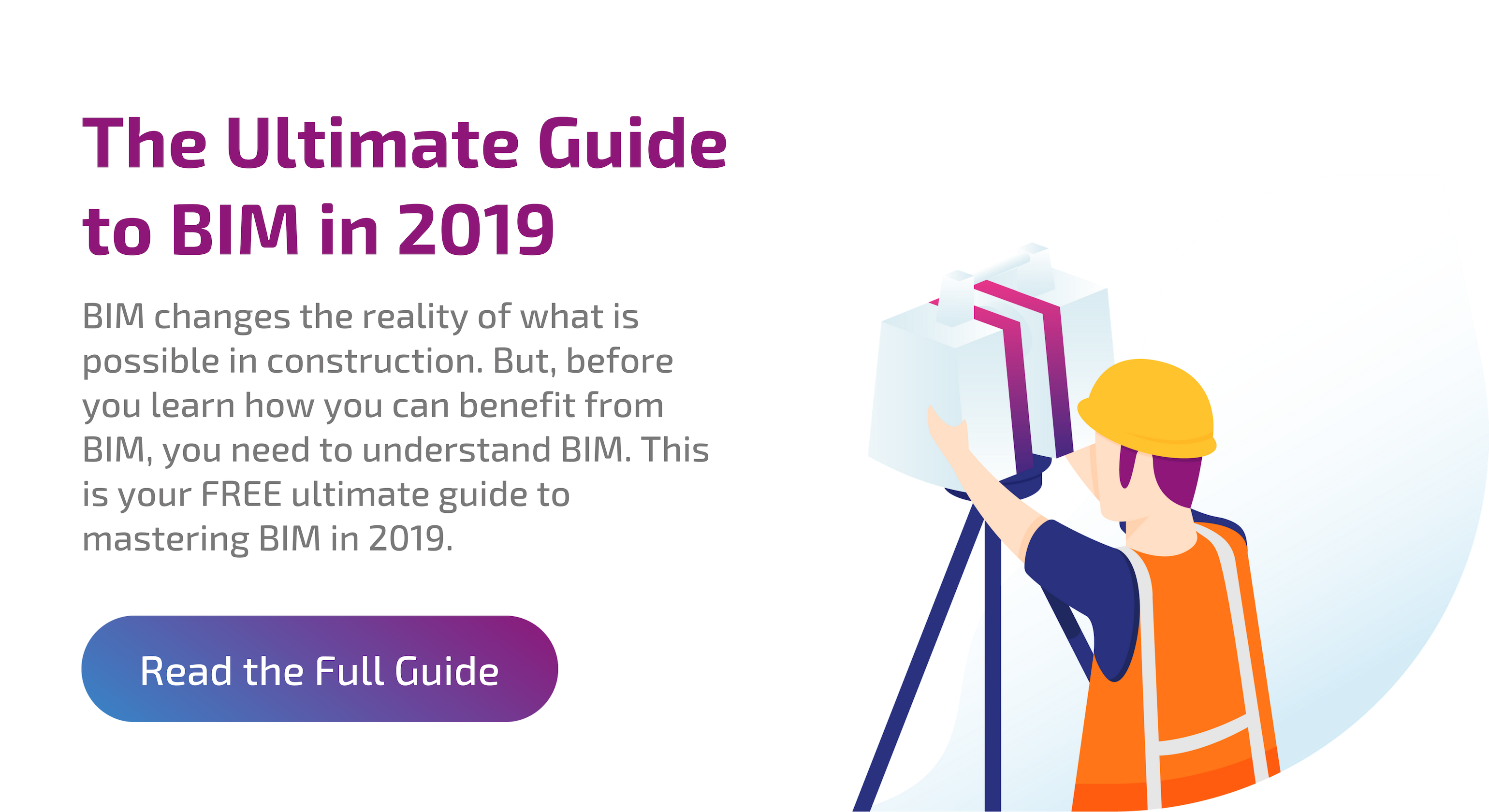Getting started with BIM: why BIM software is just the beginning

Building Information Modelling (BIM) and software solutions such as Revit, Autodesk BIM 360, Allplan, and Navisworks are sometimes viewed as one and the same thing. However, this compromises the view of what BIM is and skews the role that software plays in its execution. If approached in this way, you will only skim the surface of the true potential BIM has to offer.
BIM is more of a process than it is software. BIM is a process that is enabled by technology and software. But, what makes BIM stand out when compared to more traditional forms of computer-aided design (CAD) is how slight changes to software technology have enabled transformational developments in how design and construction can be approached as a process.
To a broad degree, things that get labelled ‘BIM’ often have nothing other than changes to process separating them from traditional CAD (computer-aided design) — if that. But, to understand this, it is important to start with a definition of BIM and explain why it can sometimes be a confusing term.
What is BIM? Why is there confusion around BIM?
The reputational rise of BIM has seen many AEC (architecture, engineering and construction) software providers grab at the terminology for marketing and PR purposes. Similarly, construction and design teams like to be able to say that they are ‘BIM-enabled’.
In 2016, the UK Government mandated the use of BIM Level 2 for all publicly funded construction projects. This saw the creation of four ‘Levels of BIM’ that capture these many uses of BIM quite well. Although only truly applicable in the UK, they provide a good rubric for understanding how BIM is used, and, arguably, misused.
BIM Level 0 essentially covers traditional CAD software. These are design solutions that have been around since the 1980s. BIM Level 1 introduces the use of non-graphical data alongside graphical CAD representations — technology that, up and to this point has been known as object-oriented CADs. In these two instances, BIM is simply being used as a new term for CAD — an issue known as ‘BIM-washing’.
BIM Level 2 sees the first departure from standard construction technology, with the introduction of requirements designed to encourage more collaborative processes. For a project to qualify as BIM Level 2, all associated CADs must be able to export projects into common file formats (IFC or COBie) and the project administrators have to create and manage a CDE (Common Data Environment) to serve as a data exchange.
Introducing BIM Level 3
BIM Level 3 is a still undefined regulatory category, but encompasses the technology that is most distinct from traditional CAD and is arguably the source of the modern fascination with the term BIM — database-first, single-source-of-truth design software.
Here, all digital tools used by different specialist across design and construction teams access a single dataset, rather than creating distinct and separate files. Architects are still able to access schedules, colour fills etc., structural engineers can still use bracing diagrams and builders isometric views of the structure. But, each is simply a specialised format for viewing a portion of the central dataset, not a distinct file by itself. This means that whenever any member of the team makes an edit to a file, that change is automatically propagated across all other files because they are ultimately one and the same. This removes almost all of the administrative burdens associated with collaboration by making the sharing and updating of information simple.
Why BIM is more than software
All of these different ‘definitions’ and ‘Levels’ of BIM are, ultimately, defined by their software characteristics. So, in that sense, BIM is software. But, in reality, the software solutions are not the important aspect of what BIM delivers. Even database-first, single-source-of-truth enabled BIM modelling software is not functionally different from standard CAD tools if accessed in isolation. From the perspective of any single member of the design or construction team, they are simply using a digital tool to aid their job that is very similar to the software solutions that have been available for the last two decades. If using a program like Revit, it might be exactly the same.
What BIM solutions change is the ability to collaborate and communicate across a team and between teams. It is the introduction of these collaborative processes that really matter. It is like the proverbial ‘cloud’. Cloud programs are software. But, the reason that they are important is how they impact workflows and the ways in which individuals access data. If you simply used a cloud solution like traditional storage, only accessing your files from a single machine and never taking advantage of collaborative sharing abilities — nothing will have changed. BIM’s real impact is as a process and approach to construction and design. That process is enabled by software, but the software is, ultimately, the least important part of the outcome.
What BIM as a process delivers
Every element of the design and construction team brings unique and specialised capabilities that are integral to the completion of the project. The ability to collaborate throughout a project allows these skills to be used to their greatest potential.
The ability to share information allows architects and designers to push the limits of possibility by bringing structural engineers in on the process early and truly embrace the limits of iterative design. It is possible to look at how different materials interact with designs and deploy computer simulations with 3D models to test plans regularly throughout design. Physics simulators can be used to challenge the integrity of designs while interior designers can access options like light simulators to view designs at different times of the day.
As the project progresses, detailed construction schedules (even complete with animations) can be made to guide construction teams and get accurate timetables for project completion. These intricate schedules even improve the use of prefabricated materials — delivering greater improvements in efficiency and pushing the bounds of structural possibly even further.
These presentation features can even be used to improve client communications, allowing clients to engage directly with 3D models even if they don’t possess specialist skills. Project managers similarly benefit from access to simplified and intuitive design formats of what are otherwise complex and specialist schematics. Although all of this is enabled by technology, it is only through updating processes that anything changes.
Scan-to-BIM: adding another element to the BIM process
The cutting edge of BIM actually goes beyond single-source-of-truth datasets and marries 3D modelling technology with 3D scanning technology. This has been spurred by advances in how 3D surveys are undertaken, and the ease with which that data can be incorporated into planning enabled by single-source-of-truth models that span the entire design and construction process.
Scan-to-BIM LiDAR (Light Detection and Ranging) techniques can be introduced to capture site details. These can inform the basis of a model, or be used throughout construction to compare stages of development to the BIM model. The latter point delivers near 100% guarantees when it comes to quality assurance, allowing for the most complex designs to be executed with confidence when scanning technology is incorporated into the construction process. This even allows for the integration of experimental technologies like 3D printing or robotic manufacturing into the construction process.
Pre-design scan-to-BIM processes are particularly suited to working on existing structures, even when using prefabricated materials. The digital scans can be used during the planning stages to identify potential clashes in a way that more traditional techniques simply cannot match. The entire project can be approached as if being modelled from scratch.
To find cost-effective ways of integrating scan-to-BIM technology into construction processes, project management needs to find surveyors who are enabled by the latest advancements within their own field. New multistage, vector-based, point cloud processing software is reducing the timescales and the labour costs involved in surveying. This type of software is able to register the many scans involved in a survey 40%-80% faster, with less oversight — allowing for the deployment of this kind of point cloud technology across the construction and design process much more freely, unencumbered by costs where the right partnerships are found.
Summary: BIM requires the right software, but its true potential is much larger
You need software to undertake ‘BIM processes’. But, it is the collaborative processes enabled by this technology that matter when it comes to outcomes. No technology solution can deliver improvements on its own.
Where BIM really delivers is in collaboration. It is by updating processes in workflows to create efficiencies and find new ways of working that will deliver outcomes that matter. The ease with which this can be done is impacted by the technology you are using, but it is the processes that count.
A team using BIM Level 2 technology (or even simple CAD solutions) that works together closely and just diligently updates shared files will reap greater benefits when it comes to outcomes than a team using BIM Level 3 software that simply carries on using traditional, siloed processes.
What makes single-source-of-truth, database-first BIM solutions different is the ease with which they enable these collaborative processes. Collaboration is made more efficient by removing administrative tasks. It also removes the threat of human error in updating and cross-referencing changes, promoting a far smoother workflow process.
Scan-to-BIM takes this one step further — introducing another technology that, again, only matters when incorporated into processes in a beneficial way. Fundamentally, what is important are outcomes. It is critical to pay attention to what type of technology is being labelled BIM — ‘BIM-washing’ is a real and unfortunate phenomenon. To have the best shot at positive process development, you need the best software solutions. That means using single-source-of-truth, database-first BIM.
But, in all cases, the outcomes are tied directly to how teams interact with the technology. The software side of BIM is only a stepping stone to increased productivity, improved quality assurance and happy clients. Your software investments will go to waste if you don’t put in the time to figure out how to best apply this new technology within your workflow environment.
You have been reading about how to get started with BIM and the differences between BIM as software and BIM as a process. If you want to learn more about how to update your processes to best match the capabilities offered by BIM, and understand the different types of BIM solutions on the market, we have written an Ultimate Guide to BIM in 2019 just for you.
Tags: bim software

